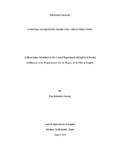Please use this identifier to cite or link to this item:
https://elibrary.tucl.edu.np/handle/123456789/2939Full metadata record
| DC Field | Value | Language |
|---|---|---|
| dc.contributor.author | Gurung, Pam Bahadur | |
| dc.date.accessioned | 2014-11-20T06:34:13Z | |
| dc.date.accessioned | 2021-07-23T04:23:31Z | - |
| dc.date.available | 2014-11-20T06:34:13Z | |
| dc.date.available | 2021-07-23T04:23:31Z | - |
| dc.date.issued | 2012-08 | |
| dc.identifier.uri | http://elibrary.tucl.edu.np/handle/123456789/2939 | - |
| dc.description.abstract | This research is an analytically study of Thōte, one of the Gurung tribal rituals, as a ‘socio-aesthetic mirror’ of Gurung identity. It explores the ritual as a reenactment of the Gurung tribal attributes and aesthetics on the one hand, and a dramatization of the socio-political agendas of their identity politics on the other. The rhythmic pattern of its performance with performers’ face and body painting, other decorations like garlands of ranijhar, tribal music, weapons, and dress code in the village to the carnival nature of mass street procession in the form of a ‘cultural collage’ including even other Gurung cultures, rituals, songs, dances, and individual creations in Pokhara reveal and identify the Gurung tribal identity and aesthetics. As a socio-political mirror, the ritual not only reflects the social, economic, religious, cultural, and geographical aspects of the community, but also most importantly shows a gradual shift in the ethnic politics. The rising identity consciousness of the tribe after the political change of Nepal in 1990 has led to the dialectics between the Thōte performance and the tribe’s identity politics. Due to the dialectics, the ritual performance has become a more per formative political discourse of dramatizing the dialogue between the tribal identity markers and the socio-political forces emerging in the local, national, and global societies. The ritual site, therefore, has turned out to be a space of enacting the intra-communal, inter-communal, and global conflicts where the tribe strategically exploits its tribal attributes, everyday, aesthetics, ‘strategic essential ism,’ and politics of negotiation and fusion to maintain their identity keeping a harmonious but conversational relation to the local, national, and global forces. As a result, the ritual performance and the Gurung identity both are in shift and becoming more cross cultural and global. | en_US |
| dc.language.iso | en | en_US |
| dc.publisher | Central Department of English Kirtipur, Kathmandu, Nepal | en_US |
| dc.subject | English literature | en_US |
| dc.subject | Gurung Identity | en_US |
| dc.subject | Gurung culture | en_US |
| dc.subject | Thōte: Shift | en_US |
| dc.subject | Ethnic Politics | en_US |
| dc.title | Performing Gurung Identity through Thōte: Shift in Ethnic Politics | en_US |
| dc.type | Thesis | en_US |
| Appears in Collections: | English | |
Files in This Item:
| File | Description | Size | Format | |
|---|---|---|---|---|
| 9310 M. Phil Thesis, Cover part.pdf | 123.02 kB | Adobe PDF |  View/Open | |
| 9310 M. Phil Thesis English Textual.pdf | 727.04 kB | Adobe PDF |  View/Open |
Items in DSpace are protected by copyright, with all rights reserved, unless otherwise indicated.
